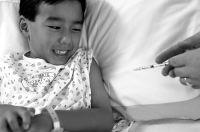Children and diabetes
1997/07/01 Urkizu, Urtzi | ZETIAZ - Elhuyar Iturria: Elhuyar aldizkaria
ZETIAZ-Elhuyar : What peculiarities does childhood diabetes have?
Luis Aldamiz-Etxeberria: The main characteristic of childhood diabetes is that, normally, the child learns to control his glucose level unlike the adult, it costs more. If your blood glucose content is not balanced, it can cause harmful effects for your health.
C.D. : Is the treatment the same?
L.A.E: Treatment is always to give that hormone that is missing by applying insulin. The amount of insulin varies depending on what the child eats. Even if it does much or little sport. Inside the body there is a perfect watch to carry your control. We apply insulin to keep blood glucose in balance.
Insulin is applied to children before meals by injections. Adults, on the contrary, can take pills.
C.D. : Can children with diabetes lead a normal life?
L.A.E: In general, children can lead a normal life. But they should take control, take injections, and measure blood glucose. It should be detected by small punctures on the tip of the finger. And so they can know exactly how many insulin they have to apply.
C.D. : What is the situation in Euskal Herria? How many children are there with diabetes?
L.A.E : It is difficult to calculate the exact number of patients, but currently in the Autonomous Community of the Basque Country there are between 160 and 170 children with diabetes. The percentages are similar to those of Europe (one diabetic child every thousand children). As for medical care, we can say that it is quite quality and we are matched to the most advanced countries.
C.D. : What novelties have occurred in recent years in medicine to combat the disease?
L.A.E: The real advances focus on insulin. Before that, Insulin came out of the pig, but now they have obtained the “copy” of Human Insulin through genetic engineering. Thanks to the genetic manipulation and experiments of the laboratories, today they have achieved new insulins that will allow them to know when they start working and when they end. Less painful injections have also been invented for children.
C.D. With the expert system “DIABETES I”, what advantages can both patients and doctors have?
L.A.E: We can divide this system into two areas. On the one hand, the diabetic child must necessarily write down the insulin he takes daily on a record sheet, keeping the changes in the amount of insulin and glucose level up to date. Therefore, the patient must take a lot of data.

On the other hand, every three months they will go to the doctor and doctors usually have quite tired of reading and interpreting the data for so many days. Through this system, the child can enter the data comfortably on his computer and this program provides information according to the data. Thus, when the consultation day arrives, the doctor should not be performing mathematical calculations and the consultation is much more effective.
C.D. Do you know other experiences that take advantage of this type of expert systems?
L.A.E: Yes, recently a US company has put on the market a similar system. However, the application, updating and commissioning of this type of systems in hospitals is for the time being quite difficult, since the costs are very high. We have been in this project for three years and although the system is finished, the work does not end there and now needs to be applied. However, this type of expert systems has more chances of success than a few years ago. Now, children easily use computers and will probably be less afraid than adults to use these systems. It will take long to apply this system, but if it is not ours it will be another.
C.D. : Do you think diabetes will ever be cured? What is the future of the disease?
E.D.L. : Looking ahead, researchers have certain challenges. He speaks, for example, of the operation of the pancreas, but his problem is that, after dying, the pancreas gets rid very quickly. In addition, after transplantation, the receptor can reject the organ.
Another option can be genetic manipulation. Genetic manipulation of insulin is considered to allow fighting the disease.
C.D. : Today, however, something seems to have been advanced. Is it not more controlled than a few years ago?
E.D.L. : If it is more controlled, but can still be considered a very problematic disease. Before for children this disease was more serious, but now with insulin injections it is not so much. In the case of adults, diabetes can lead to other health problems and be at risk for other diseases by people over 60.

Gai honi buruzko eduki gehiago
Elhuyarrek garatutako teknologia






